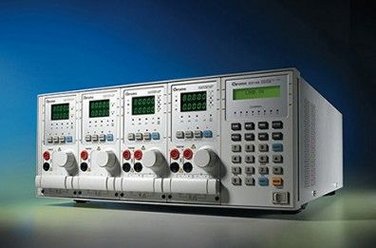LED Load Simulator for LED Power Driver Test
|
 |
 Chroma Model 63110A LED Load Simulator |
|
As a constant current source, the LED driver has an output voltage range with a constant output current. LED drivers are usually tested in one of the following ways:
- With LEDs
- Using resistors for loading
- Using Electronic Loads in Constant Resistance (CR) mode, or Constant Voltage (CV) mode
 As shown on the V-I curve in figure 1, the LED has a forward voltage VF and a
operating resistance (Rd). When using a resistor as loading, the V-I curve of
the resistor is not able to simulate the V-I curve of the LED as shown in
blue on figure 1. This may cause the LED driver to not start up due to the
difference in V-I characteristic between the resistors and the LEDs.
As shown on the V-I curve in figure 1, the LED has a forward voltage VF and a
operating resistance (Rd). When using a resistor as loading, the V-I curve of
the resistor is not able to simulate the V-I curve of the LED as shown in
blue on figure 1. This may cause the LED driver to not start up due to the
difference in V-I characteristic between the resistors and the LEDs.
When using Electronic Loads, the CR and CV mode settings are set for when the LED
is under stable operation and therefore, is unable to simulate turn on or PWM
brightness control characteristics. This may cause the LED driver to function
improperly or trigger it's protection circuits.
These testing requirements can be achieved by using a LED as a load; however,
issues regarding the LED aging as well as different LED drivers may require different types
of LEDs or a number of LEDs. This makes it inconvenient for mass production testing.
Chroma has created the industries first LED operating mode for simulating LED
loading with our 63110A load model from our 6310A series Electronic Loads. By
setting the LED driver's output voltage, and current, the Electronic Load can
simulate the LED's loading characteristics. The LED's forward voltage and
operating resistance can also be set to further adjust the loading current and
ripple current to better simulate LED characteristics. The 63110A design also
has increased bandwidth to allow for PWM dimming testing.

Figure 2 shows the current waveform from a LED load. Figure 3 shows the
current waveform from 63110A's LED mode load function. From figures 2 and 3, the
start up voltage and current of the LED driver is very similar. Figure 4 shows
the dimming current waveform of the LED. Figure 5 shows the dimming current
waveform when using 63110A as a load.

The internal resistance (Rr) can be adjusted to simulate the LED driver
output ripple current. The traditional E-load can not simulate the ripple
current of LED shown as Figure 6. Figure 7 shows the ripple current waveform
from a LED load. Figure 8 shows the ripple current waveform from the 63110A LED
mode load function.

Figure 9 shows the current waveform from a resistive load. Figure 10 shows
the current waveform from a CR mode of an Electronic Load loading. Figure 9 and
10 current waveform differs significantly from that of LED loading, especially
the voltage and current overshoot, which may cause the LED driver to go into
protection. Using resistive load or CR mode to test LED drivers may cause the
LED drivers to fail to turn on as shown in Figure 11.

| Model | Description |
|---|---|
| 63110A | LED Load Simulator 500V/2A/100Wx2 channels |
| 63113A | LED Load Simulator 300V/20A/300W |
| 63115A | LED Load Simulator 600V/20A/300W |
| 6312A | Mainframe for 2 Modules |
| 6314A | Mainframe for 4 Modules |
| A631000 | GPIB Interface |
| A631003 | USB Interface |

